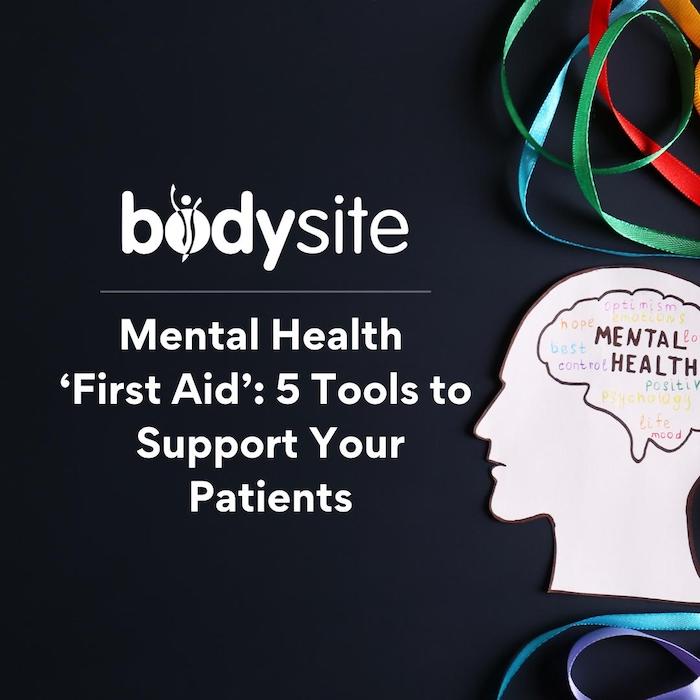Mental Health ‘First Aid’: 5 Tools to Support Your Patients

Despite today’s growing rates of clinical depression, anxiety and other pressing mental health issues1 healthcare providers outside the field of psychology still feel underprepared to tackle issues relating to mental health. The problem? Primary care providers and practitioners that patients regularly visit, are the first to field these mental health challenges, not psychiatrists or psychologists.2
Regardless of what type of healthcare practitioner you are, a patient’s visit with you could be the difference between them getting the mental healthcare they need or not.
Knowing this, it’s important to prepare for these conversations and strategize initial treatment options for your patients. Here are 5 tools you can use to get the ball rolling on assisting your patient with their mental health.
1. Communication In Office and Remotely:
Think about it — if patients aren’t prompted about their mental health what is the likelihood that they will bring it up organically? It’s fair to say that if we only relied on patients to tell us about their mental health, unprompted, we would at least miss a portion of them.
This isn’t usually the case in regards to the patient’s physical condition. Practitioners know exactly which questions to ask regarding general health and chronic health conditions.
Therefore, just like questions about physical health, don’t skip questions regarding mental health during a patient’s visit with you. Even if they confirm everything is fine, you can always recommend that if anything changes that they schedule an appointment with you.
So now that you’ve finished your brief appointment with your patient and you’ve listened to their concerns, it is crucial that you establish a way to remotely and privately communicate with them in between office visits.
Utilizing HIPAA compliant telemedicine and communication tools will allow you to schedule follow up appointments or communicate on an as-needed basis. Knowing that patients have a way to contact you will help establish peace of mind for not just them but for you as their provider.
Set expectations for how this will work for the two of you — the important part is that the patient knows that they’re not alone once they’ve left your office.
2. Plan/Tasks:
Listening and offering a means to communicate in between visits is important. But what else can patients do when they’re not seeing you?
That’s where it’s important to provide them with daily care instructions or even a daily care program. Using this tool will help your patient to work towards healthier habits as it relates to their initial treatment.
Brochures and paperwork are great but they’re often too broad and in many instances your paperwork can end up in the patients’ trash, either purposefully or accidentally.
Arm your patients with one of your existing care plans or a done-for-you care plan in a digital and trackable format. This way your patient can read your care instructions every day and stay on track with their health goals and perform any tasks or care instructions you prescribe, from wherever they are.
One example of a digital mental health care plan is the 21 Days of Mindfulness, powered by BodySite.
3. Diet/Exercise:
As mentioned above, other helpful digital programs could focus on a change to the patient’s diet and/or exercise.
A basic walking plan for example, could be a great start to help kickstart mood boosting neurotransmitters. Whereas, a healthy eating program could help patients to begin consuming foods that help ease the symptoms of their mental health issues.3
4. Supplements and/or Medication:
When exploring all options, you may find that the patient needs the assistance of supplements or even medication.
Taking into account their medical history, feelings towards a prescription and other healthcare professionals involved you and your patient can come to a consensus on what is right for them and when.
5. Referrals and Partners:
The final tool for helping your patients is to refer them to a psychologist or psychiatrist that can further assist and/or collaborate with you in the care of your patient.
Below is a model of proposed variations of care between a primary care practitioner and behavioral health specialist:

Caption: Heath, B. W. R. P., Pam Wise Romero, and Kathy Reynolds. “A standard framework for levels of integrated healthcare.” Washington, DC: SAMHSA-HRSA Center for Integrated Health Solutions (2013) 2,4
As outlined above, there are many ways in which psychologist and psychiatrist professionals can work in tandem with you as a patient’s practitioner.
Establishing these relationships for your patient will best assist them in receiving the care they need in order to begin tackle their mental health issues. Whether you’re able to help them through their entire journey or you involve the help of another professional, what’s most important is knowing your options and finding the right path for patient, with your patient.
How BodySite Can Help:
If you’re interested in a private labeled remote patient care solution that can help facilitate the mental health care of your patients once they leave the office, look no further than BodySite.com.
BodySite is a remote patient care and monitoring platform that promotes better care and allows you to easily enroll patients into care and wellness plans so patients receive your guidance, support, and instructions every day via tools such as telemedicine, remote patient monitoring, automated patient education and more.
Click here to claim your 30-Day Free Trial or click here to learn more.
SOURCES:
1. https://mhanational.org/sites/default/files/2022%20State%20of%20Mental%20Health%20in%20America.pdf
2. https://www.sciencedirect.com/science/article/pii/S1555415520303858
3. https://www.ncbi.nlm.nih.gov/pmc/articles/PMC6170050/#:~:text=Helping%20patients%20to%20eat%20a,easily%20be%20integrated%20into%20health
4. https://www.pcpcc.org/sites/default/files/resources/SAMHSA-HRSA%202013%20Framework%20for%20Levels%20of%20Integrated%20Healthcare.pdf
